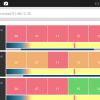-
Posts
812 -
Joined
-
Last visited
Content Type
Profiles
Forums
Gallery
Events
Blogs
Posts posted by frugal
-
-
The tutorial has been great for setting up Astrotortilla and a local astrometry.net server.
The only correct I would liketo make it with regard to Scale Minimum and Scale Maximum. The tutorial uses "degwidth" as the scale unit. In this case degwidth is literally the width of the image in degrees, so Scale Minimum and Scale Maximum both refer to the image width, rather than both width and height as the tutorial sets out.
As an example, on my set up the image size is 2.45x1.50 degrees, and if I use Scale Minimum as 2.4 and Scale Maximum as 2.5 it works perfectly well, and even faster than if I use Scale Minimum as 1.5
-
From the error it looked like Python was not installed on the failing installation.
-
I unintelligible AstroTortilla as it was taking far too long on my venerable old 8th going laptop. I might reinstall it and have another go now.
-
-
Just had my baby out after almost a year with the new camera - and suddenly it started raining. So I hurriedly ran everything inside. Now, 30min later it's clear skies...

I'm going to sleep...
It has been on-again, off-again all evening east of the river as well.
-
I live about 70 miles up the M5, but the Severn estury does wierd things to cloud formation.You obviously don't live anywhere near me then!

Sent from my SM-P900 using Tapatalk
-
I think it is broken. It has started to show lots of green all over the place. That can't be right can it?...

Sent from my SM-N9005 using Tapatalk
-
If anybody else finds any quirks then please email them to us directly: bugs@clearoutside.com - I can then follow up with you directly and request further info etc.. if needed.
I have sent you an email with all of the details I could think of that were relevant.
-
Yes
 - hopefully for both Android and IOS.
- hopefully for both Android and IOS.For now, the site is responsive and will adapt to varying screen sizes so it should at least be usable on all devices but, the level of data shown will be reduced on small screens so that it's still readable.
Grant, In some cases it is trying to be too helpful
 I have a large smart phone (Note 3), and it only displays every 4th hour, even though there is space for far more information. Also, for some reason the expansion of a day to show more data is not working on the phone. On the tablet and the laptop it is all working fine.
I have a large smart phone (Note 3), and it only displays every 4th hour, even though there is space for far more information. Also, for some reason the expansion of a day to show more data is not working on the phone. On the tablet and the laptop it is all working fine. -
Thanks for the responses, however I am still not sure how accurate I should be getting the alignment in the first place. I know I should be getting the alignment as good as possible, however I do not know how close I am to the target accuracy.
I managed a 1 arc minute deviation in Alt and Az. Is that considered accurate? Should I be trying to get it down to only a couple of arc seconds? Or is anything under a degree good enough?
After a star alignment the mount will give me a deviation from alignment, but I have no idea if that deviation is acceptable or if I need to go through the process again.
Sent from my SM-N9005 using Tapatalk
-
The weather has finally cleared enough that I can actually use the scope the I bought in the FLO clearance sale a while ago. I spent a good while setting up the scope in the light. I collimated the polar scope and when it got dark I polar aligned as accurately as I could.
When I performed a two star alignment it reported a polar alignment error of about 1 arc minute in either axis. Seeking across to targets got them on screen first time every time.
My question is: Is a polar error of 1 arc minute considered accurate?
About half of the 150 second subs had nice round stars, however the other half had eggy stars (but I think that this had more to do with the balance being slightly camera end heavy)
Sent from my SM-P900 using Tapatalk











Debayering a DSLR's Bayer matrix.
in DIY Astronomer
Posted
This may seem like a daft question, but did you check that the camera worked with your scope before you disassembled it? Otherwise, if it fails when you put it back together you will not know if it was something you did, or if it really was dead to begin with.